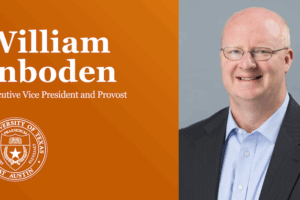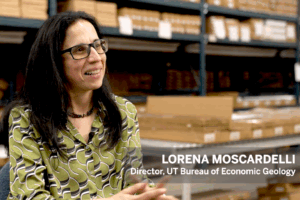“Through the very principle of this acquisition, we affirm the importance of the essential practices of a free press, particularly the protection of sources, to a constitutional society. We also affirm the central importance of ethical leadership. Bob Woodward and Carl Bernstein have taught more than one generation already, and through their lasting tie with The University of Texas at Austin, will teach generations more.”
The contract between the university and the reporters reflects more than a year of extensive discussion between Woodward and Bernstein and Faulkner about how the interests of history and journalistic ethics—particularly the cardinal principle of a reporter’s obligation to protect confidential sources promised anonymity—could each be served without compromise. The preamble to the agreement signed by Woodward, Bernstein and, on behalf of the university, Faulkner, states:
|
Woodward, Faulkner and Bernstein signing the agreement in the Stark Library.
|
“The Watergate reporting of Bob Woodward and Carl Bernstein from 1972 to 1976, for The Washington Post and for their two co-written books, All The President’s Men and The Final Days, generated an immense amount of working material and files, including contemporaneous notes of interviews with sources; memos to each other; story drafts; interview transcripts; notebooks; tape recordings; memos to editors; research and backup materials; and chapter drafts of books.
“From the day following the break-in through publication of The Final Days, both Woodward and Bernstein retained virtually all of their notes and related material which they have since maintained and preserved separately.
“It is their intention to bring all the material together into one archive, and have it catalogued and preserved in such a manner that journalists, historians, students and interested citizens can have access to it for perpetuity. In so doing, the authors’ foremost consideration has been the question of how to guaranty the confidentiality of sources who are still alive and do not wish their identities disclosed in their lifetimes, while maintaining the integrity of both the journalistic and historical process.
“The University of Texas and the Harry Ransom Humanities Research Center have the facilities and expertise to implement such a plan, and this agreement is intended to serve the interests of history and journalism while ensuring that the confidentiality of Woodward and Bernstein’s sources will be preserved during the lifetime of those who were promised anonymity as part of the reportorial process and who still desire that anonymity during their lifetime.
“The terms of transfer of Woodward and Bernstein’s files and the organization of the archive will ensure that this principle is observed even beyond the lifetimes of Woodward and Bernstein, if necessary.”
A separate “good faith provision” of the agreement notes that,
“Throughout the negotiation of this agreement, the University of Texas has demonstrated and promises to maintain an absolute commitment to the principles of journalistic integrity and the protection of the identity of confidential sources during their lifetimes. Woodward and Bernstein are equally committed to total disclosure of the contents of all their notes and files related to Watergate, and to serving the interests of further historical and journalistic inquiry surrounding the events of Watergate consistent with their obligations to their journalistic sources…. Woodward and Bernstein want the Archive to provide a comprehensive and authoritative history of their work together.”
|
Woodward, Bernstein and Staley at the press conference announcing the acquisition.
|
Because nearly three decades have passed since their Watergate reporting, which at its outset was attacked by the Nixon White House and even fellow journalists, “we felt it is finally time to make the basis of our work available to everyone,” Bernstein said. “Our partnership with the university will allow most of the material to be made public within a year.”
Woodward noted, “Our Watergate reporting for the Post, and our two books, were the subject of substantial controversy at the time. Over the last three decades the emergence of the historical record has demonstrated the validity of our work, but not always what it was based on. A full disclosure of all our files and material will add to the understanding of the Watergate era and help pinpoint how we were able to obtain information and who precisely helped us. At the same time, the expertise and facilities of the Ransom Center will ensure that the full record, properly reviewed and archived, will eventually be available while guaranteeing that the pledge of confidentiality to sources will be maintained throughout the lifetime of those sources.”
The archive provides a meticulous account of the reporting of one of the truly momentous political and journalistic events of the last century. Woodward and Bernstein, then 29 and 28 years old, respectively, were the first journalists to establish the connection between the June 17, 1972, break-in at the Democratic National Headquarters in the Watergate complex and aides to President Richard M. Nixon. Within four months, their reporting established that Watergate was not about an isolated break-in, but rather was part of criminal conspiracy to disrupt the 1972 presidential election through an extensive campaign of political espionage and sabotage directed from the White House. The reporting of Woodward and Bernstein helped earn The Washington Post the 1973 Pulitzer Prize for Public Service. President Nixon, facing certain impeachment and conviction by the Senate for his role in the illegal activities and their coverup, resigned in August 1974. Forty government officials and members of Nixon’s re-election committee were indicted and convicted of felony charges. Most were sentenced to jail terms.
From the beginning of their investigation, Woodward and Bernstein preserved almost all of their work papers, including handwritten and typed notes of their interviews with sources (more than 250 pocket-sized notebooks are included in the archive), memos between themselves, memos sent to The Post’s editors by the reporters, story drafts, clippings, photographs and memorabilia. The result is a complete record of their coverage of Watergate story from beginning to end, far more extensive than their abbreviated account in All The President’s Men, published in 1974, and re-created as a movie starring Robert Redford and Dustin Hoffman in 1976.
|
Woodward reading the Daily Texan in the President’s office.
|
Immediately after Nixon’s resignation, Woodward and Bernstein (often collectively called “Woodstein” by The Post’s editors) took a leave of absence from the paper and undertook a finely detailed account of the President’s determined—and criminal—attempt to stay in office after the Watergate break-in. The 476-page book that resulted, The Final Days, generated immense controversy (and one of the largest non-fiction book sales in history) when it was published in 1976. Particularly controversial were the reporters’ extensive use of confidential sources to build their picture of Nixon and his political, emotional and physical deterioration. The archive addresses a range of issues concerning the first amendment, the abuse of political power, ethics in journalism and the functioning of the democratic process itself.
Woodward and Bernstein have agreed that they will devote substantial time to assisting university archivists in assembling and cataloguing their papers. They will also participate in a series of conferences, public lectures and educational programs at the university to help students, scholars and the public analyze and debate the Nixon era, Watergate and journalism.
One unique aspect of the archive is its demonstration of how the initial investigation and basic narrative of a national event—Watergate—was based largely on information obtained and accumulated by journalists, not documents in government custody. With the material in Woodward and Bernstein’s heretofore confidential files a fuller record of Watergate can be built.
“In the years since Nixon’s resignation, the release of more of his Oval Office tapes has deepened our understanding of the man and what happened in Watergate,” Bernstein said. “Until now, our papers and notes have never been subject to any kind of public access. When scholars and citizens examine some of these notes and memos, and come to understand where we were getting our information from, a larger, more informed historical record will be possible.”
“The collection traces a brilliant narrative of one of the most defining events in American politics,” said Thomas F. Staley, director of the Ransom Center. “With the reporters’ zeal and the publisher’s and editor’s commitment, it is a dramatic story of the triumph of American journalism at its best. Students, legal scholars, political historians, journalists and the public will have the opportunity to look at Watergate from an insider’s perspective, including investigating and researching new dimensions of the account. The multi-disciplinary nature of the archive is far reaching.”
The Ransom Center will process the collection, including its arrangement, description and preservation. The archive’s location-aids and catalog records will be made available via the Web, providing virtual visitors an overview of one of the 20th century’s most intriguing stories. The Ransom Center anticipates the cataloging to take one year.
|
The university will establish the Woodward-Bernstein Watergate Archive at its Harry Ransom Humanities Research Center in Austin.
|
A lead story in the New York Times Arts section in February described the extraordinary literary and cultural treasures of the Ransom Center and called the center “one of the world’s pre-eminent research libraries.”
“From the beginning, once we were introduced to the Ransom Center, we thought this was the logical repository for our archive,” Bernstein said. Woodward added, “Its international recognition as a research library, its superior conservation abilities and its accessibility to the public were high priorities for us.”
Woodward and Bernstein’s introduction to the Ransom Center was made by New York rare book dealer Glenn Horowitz, who has been their representative in the transaction. Horowitz has facilitated other acquisitions for the university.
The Watergate Archive adds considerably to the Ransom Center’s rich collection of political, historical and legal archives, including letters of Thomas Jefferson; the collection of the late Secretary of State John Foster Dulles, a compilation of furnishings, books and personal items of several generations of the Dulles family; materials from reporter Mike Wallace’s 1958 “Fund for the Republic” interviews; the John Valentine Collection of Franklin D. Roosevelt; the archive of Morris L. Ernst, a civil rights and free speech attorney; archive of Alexander Kerensky, leader of the provisional government of Russia in 1917; a massive archive of London Observer editor Louis Garvin; and a recent acquisition of philosopher, economist and Encounter editor Maurice Cranston.
In early May the Ransom Center opens its doors to its newly constructed public space, including the Ransom Galleries, exhibition space to spotlight the Center’s riches; the 129-seat Prothro Theater, a state-of-the-art space for readings, lectures, film and performances; as well as permanent exhibitions of the Gutenberg Bible (c. 1450) and the world’s first photograph (c. 1826). The second floor features new public research facilities, including reading rooms and seminar and viewing rooms.
For more information contact: Don Hale, 512-471-3151.
Photos: Marsha Miller
[Click on photos for downloadable hi-res images.]







